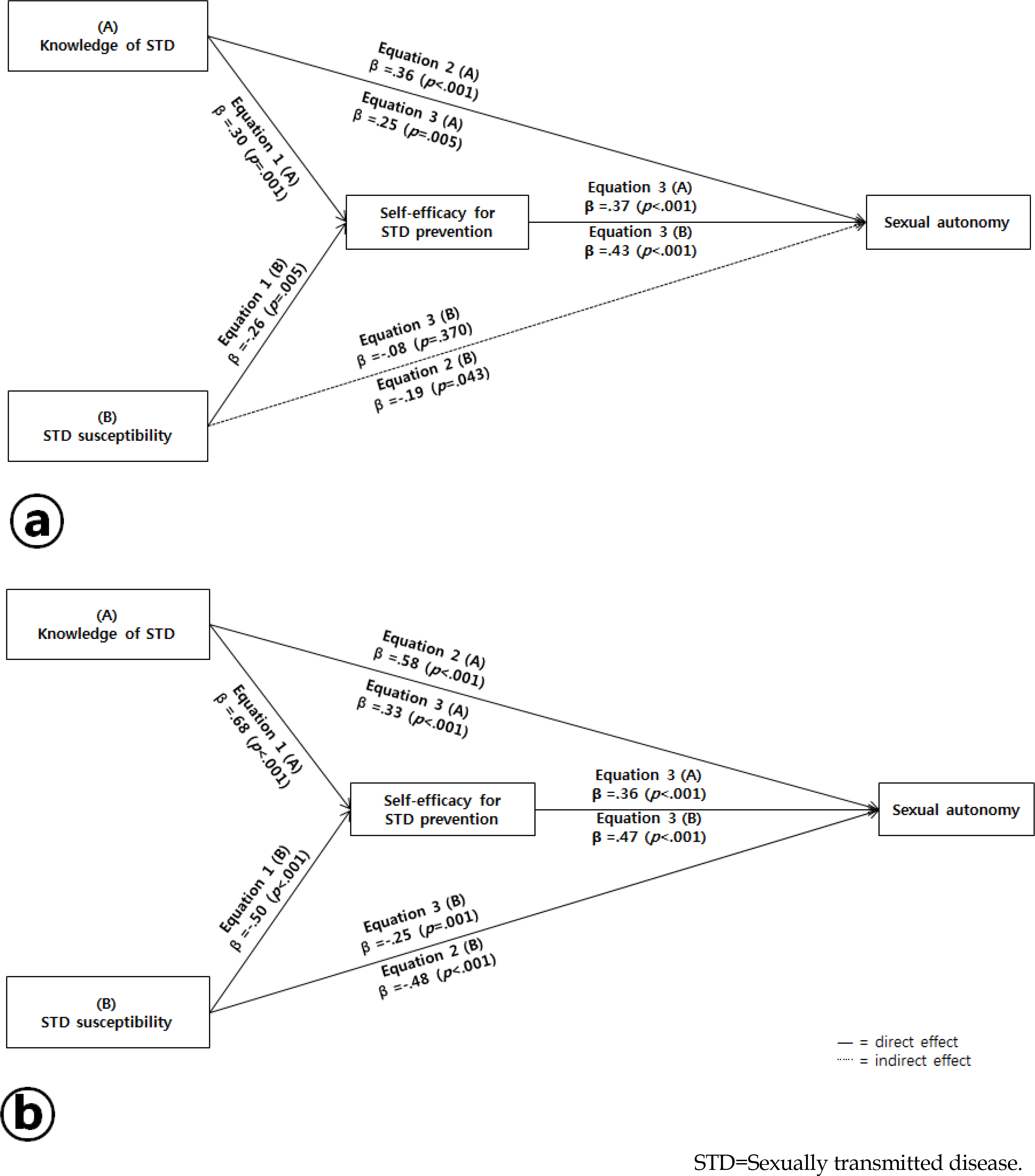Korean J Adult Nurs.
2016 Aug;28(4):482-490. 10.7475/kjan.2016.28.4.482.
Gender Difference in Mediating Effects of Self-Efficacy for the Prevention of Sexually Transmitted Diseases (STD) among College Students' STD Knowledge, Susceptibility, and Sexual Autonomy
- Affiliations
-
- 1Department of Nursing, Hoseo University, Asan, Korea. mijeong@hoseo.edu
- KMID: 2351411
- DOI: http://doi.org/10.7475/kjan.2016.28.4.482
Abstract
- PURPOSE
The purpose of the study was to examine the impact of self-efficacy in the prevention of sexually transmitted diseases (STD), knowledge of and susceptibility to STD, and the role of gender in sexual autonomy.
METHODS
Data were collected from 267 college students using self-report questionnaires during the period from the first to the twentieth of June 2015. Data were analyzed using χ² test, Fisher's exact test, t-test, Pearson correlation coefficients, simple and multiple regression techniques with the PASW/WIN 20.0 program. Mediation analysis was performed according to the Baron and Kenny method and Sobel test.
RESULTS
In male students, self-efficacy for STD prevention showed a full mediating effect in the relationship between STD susceptibility and sexual autonomy (β=-.08, p=.370). But in female students, it had a partial mediating effect (β=-.25, p=.001). And self-efficacy for STD prevention showed partial mediating effects in the relationship between knowledge of STD and sexual autonomy in the both male (β=.25, p=.005) and female students (β=.33, P<.001).
CONCLUSION
To enhance college students' sexual autonomy, it may be useful to build effective strategies enhancing students' knowledge about and susceptibility to STD and to develop a self-efficacy promotion program for college students.
MeSH Terms
Figure
Reference
-
1.Shin YH., Chun YK., Cho SM., Cho YR. The effects of a sex education program on knowledge related to sexually transmitted disease and sex autonomy among university students. Journal of Korean Academy of Nursing. 2005. 35(7):1304–13.2.World Health Organization media Centre. Sexually transmitted infections (STIs). WHO;2015. [cited 2016 January 20]. Available from:. http://www.who.int/mediacentre/factsheets/fs110/en/.3.Westrom L., Joesoef R., Reynolds G., Hagdu A., Thompson SE. Pelvic inflammatory disease and fertility. A cohort study of 1,844 women with laparoscopically verified disease and 657 control women with normal laparoscopic results. Sexually Transmitted Diseases. 1992. 19(4):185–92.4.Lee SJ., Ha US., Kim SW., Cho YH., Yoon MS. Prevalence of chlamydial and gonococcal infections and sexual behavior in university students in Korea. Korean Journal of Urology. 2004. 45(7):707–13.5.Kim KW., Kang KH., Jeong GH. Self-efficacy and sexual autonomy among university students. Journal of Korean Public Health Nursing. 2012. 26(1):51–9. http://dx.doi.org/10.5932/JKPHN.2012.26.1.051.
Article6.Woo NS., Ka YH. A study on the sexual knowledge, sexual attitudes and sexual behavior in Korean and American college students. The Korean Journal of Woman Psychology. 2005. 10(2):113–33.7.Kang HS., Jang SB. Development of college student's condom attitude scale. Journal of Korean Academy of Nursing. 2004. 34(5):751–9.
Article8.Ko YS. A study on male and female university students' sexual attitude and sexual behavior [master's thesis]. Seoul: Ewha Womans University;2001.9.Choi MS., Ha NS. A study on the knowledge, attitude, and experience in sex and sexual autonomy of college students. Korean Journal of Women Health Nursing. 2004. 10(4):318–30.10.Wolf S. Freedom within reason. Oxford: Oxford University Press;1994.11.Kim SJ. Predictors of male college students' condom use based upon the health belief model. [master's thesis]. Suwon: Ajou University;2009.12.Chang SB. Development of sexual autonomy measurement for college students. Korean Journal of Women Health Nursing. 2002. 8(1):106–15.
Article13.Cho GY., Kim YH. Factors affecting sexual autonomy among female university students. Journal of the Korea Academia-Industrial cooperation Society. 2014. 15(11):6710–8. http://dx.doi.org/10.5762/KAIS.2014.15.11.6710.
Article14.Shim CS., Lee YS., Oh SH. Study on the relationship between gender-role stereotypes, sexual assault awareness and permissible limit in the college students. Korean Journal of Women Health Nursing. 2012. 18(2):117–25.
Article15.Yoo MS., Park JW., You MA. The relationships among gender egalitarianism, sexual attitudes and sexual harassment myths among Korean university students. Journal of Korean Society Maternal and Child Health. 2012. 16(1):14–22.16.Faul F., Erdfelder E., Buchner A., Lang AG. Statistical power analyses using GPower 3.1: Tests for correlation and regression analyses. Behavior Research Methods. 2009. 41(4):1149–60.17.Mahoney CA., Thomb DL., Ford OJ. Health belief and self-efficacy models: their utility in explaining college student condom use. AIDS Education and Prevention. 1995. 7(1):32–49.18.Baron RM., Kenny DA. The moderator-mediator variable distinction in social psychological research: conceptual, strategic, and statistical considerations. Journal of Personality and Social Psychology. 1986. 51(6):1173–82.
Article19.Sobel ME. Asymptotic confidence intervals for indirect effects in structural equation models. Sociological Methodology. 1982. 13:290–312.
Article20.Shin KR., Park HJ., Kang MJ., Park IS., Bae KE., Seo SR, et al. Survey on actuation sexual attitude among college students. Health Promotion Research Report. Reston: Korea Health Promotion Foundation;2011. November.21.Lee HK. Predictors of condom use intentions according to experience of sexual intercourse in male college students. Korean Journal of Women Health Nursing. 2010. 16(2):194–203. http://dx.doi.org/10.4069/kjwhn.2010.16.2.194.
Article22.Ji SH., Kang YS. Discussion on mediation tests of structural equation model in social science field. Journal of the Korean Data Analysis Society. 2014. 16(6):3121–31.23.Preacher KJ., Hayes AF. SPSS and SAS procedures for estimating indirect effects in simple mediation models. Behavior Research Methods, Instruments, & Computers. 2004. 36(4):717–31.
Article24.Rucker DD., Preacher KJ., Tormala ZL., Petty RE. Mediation analysis in social psychology: current practices and new recommendations. Social and Personality Psychology. 2011. 5(6):359–71. http://dx.doi.org/10.1111/j.1751-9004.2011.00355.x.
Article
- Full Text Links
- Actions
-
Cited
- CITED
-
- Close
- Share
- Similar articles
-
- The Effects of a Sex Education Program on Knowledge Related to Sexually Transmitted Diseases and Sexual Autonomy among University Students
- First Coital Age and Risky Sexual Begavior Assiciated with Sexually Transmitted Diseases
- An Epidemiological Evaluation on the Sexual Partners of Male Patients with Sexually Transmitted Diseases
- Sexual Autonomy in College Students
- Sexual Behavior and Awareness on STD in the Elderly


